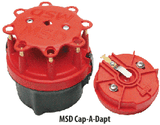Oil Viscosity - Does your Weight make the Grade?
From Driven Racing Oil
Viscosity is the most important property of a lubricant. Understanding viscosity promotes the ability to reduce wear, improve fuel economy and make more horsepower.
For starters, in oil nomenclature, “W” does not stand for “Weight”. It stands for “Winter” and that is the key to understanding viscosity grades. A 10W-30 is a multi-grade (two viscosities) motor oil, and as the name implies, it meets more than one grade. Forty years ago there were winter grades for cold weather and summer grades for warmer weather. A typical winter grade was 10W. A typical summer grade was 30. These oils were straight grade oils. A 10W flows well in cold weather, to protect the engine at start up, but it’s is too thin for use in the summer. A 30 grade grade oil, thick enough to protect in the heat, was recommended for summer use.
Then, multi-grade oils were formulated. A 10W-30 had the winter cold start flow properties of a 10W and the summer, high temperature thickness of a 30 grade. Multi-grade oils could stay as close to the optimum viscosity over a range of temperatures - not too thick when it is cold and not too thin when it is hot.
The difference between a 0W-30 and a 10W-30 is indicated by how well each flows at lower temperatures. The viscosity of hot oil is measured using different test parameters than when the oil is cold, so the numbers after the “W” don’t relate to the numbers in front of the “W”. The difference between 10W-30 and a 10W-40 is the high temperature viscosity. Obviously, a 10W-40 is thicker than a 10W-30 at high temperature.
Armed with knowledge of viscosity grades, how can we put it to good use? Remember that using oil with a viscosity that is too high can result in excessive oil temperature and increased drag. Using an oil with a low viscosity can lead to excessive metal to metal contact between moving parts. Using the correct viscosity oil eases starting, reduces friction and slows wear.
For even more effective start up protection, use a synthetic 10W-40 instead of a conventional 20W-50. The synthetic 10W-40 flows easily and still maintains enough viscosity to protect piston skirts and bearings when it gets hot. The improved temperature stability of synthetics make them a better choice for race engines and serious high performance engines. Even with a synthetic, however, viscosity changes with temperature. Selecting the correct viscosity for an application requires knowing the operating temperature of the oil. Engines that run high operating oil temperatures require higher viscosity oil.
Engines that run low oil temps require lower viscosity oil. Look at an NHRA Pro Stock engine, a NASCAR Sprint Cup engine and a World of Outlaws 410 Sprint engine. Each engine has a very different operating oil temperature – Pro Stock, 100°F; NASCAR, 220°F and sprint cars, 300°F. All three engines run very different viscosity oils as well − SAE 0W-5, SAE 5W-20 and SAE 15W-50.
Here’s another thought regarding viscosity. It is vitally important to keep internal engine clearances in mind. Looser clearances in the engine and oil pump require higher viscosity oil to maintain oil pressure. Tighter clearances need lower viscosity oil, which provides better cooling and improved horsepower.
Armed with knowledge of viscosity grades, you can now select the right one. In return, you will prevent wear, improve fuel economy and make more horsepower.
Recent Posts
-
Avoiding Charging System Problems
A properly functioning charging system is critical for a vehicle’s operation.Often taken for granted …Jul 13th 2020 -
Solving Ignition Problems: The Path of Least Resistance
Ignition problems can be a major source of performance issues, but are often one of the easiest chal …Mar 15th 2020 -
Spring Maintenance Checklist to Keep Your Race or Performance Car Running Great
If you drove your race or performance car into the garage last fall and haven’t touched it since, it …Mar 10th 2020


